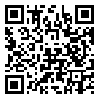Volume 75, Issue 5 (August 2017)
Tehran Univ Med J 2017, 75(5): 374-380 |
Back to browse issues page
Download citation:
BibTeX | RIS | EndNote | Medlars | ProCite | Reference Manager | RefWorks
Send citation to:



BibTeX | RIS | EndNote | Medlars | ProCite | Reference Manager | RefWorks
Send citation to:
Tighnavard Bejarbane R, Daie Ghazvini R, Mahmoudi S, Soltani Moghaddam R, Safara M, Bakhshi H et al . Diagnosis of fungal keratitis in patients with corneal lesions at Amiralmomenin hospital in Rasht, Iran. Tehran Univ Med J 2017; 75 (5) :374-380
URL: http://tumj.tums.ac.ir/article-1-8222-en.html
URL: http://tumj.tums.ac.ir/article-1-8222-en.html
Rhoghaye Tighnavard Bejarbane1 
 , Roshanak Daie Ghazvini1
, Roshanak Daie Ghazvini1 
 , Shahram Mahmoudi2
, Shahram Mahmoudi2 
 , Reza Soltani Moghaddam3
, Reza Soltani Moghaddam3 
 , Mahin Safara1
, Mahin Safara1 
 , Heidar Bakhshi1
, Heidar Bakhshi1 
 , Parivash Kordbacheh *
, Parivash Kordbacheh * 
 4
4

 , Roshanak Daie Ghazvini1
, Roshanak Daie Ghazvini1 
 , Shahram Mahmoudi2
, Shahram Mahmoudi2 
 , Reza Soltani Moghaddam3
, Reza Soltani Moghaddam3 
 , Mahin Safara1
, Mahin Safara1 
 , Heidar Bakhshi1
, Heidar Bakhshi1 
 , Parivash Kordbacheh *
, Parivash Kordbacheh * 
 4
4
1- Department of Medical Parasitology and Mycology, School of Public Health, Tehran University of Medical Sciences, Tehran, Iran.
2- Department of Medical Parasitology and Mycology, School of Public Health, Tehran University of Medical Sciences, Tehran, Iran. Students’ Scientific Research Center, Tehran University of Medical Sciences, Tehran, Iran.
3- Department of Ophthalmology, Amiralmomenin Hospital, School of Medicine, Gilan University of Medical Sciences, Rasht, Iran.
4- Department of Medical Parasitology and Mycology, School of Public Health, Tehran University of Medical Sciences, Tehran, Iran. ,pkordbacheh@tums.ac.ir
2- Department of Medical Parasitology and Mycology, School of Public Health, Tehran University of Medical Sciences, Tehran, Iran. Students’ Scientific Research Center, Tehran University of Medical Sciences, Tehran, Iran.
3- Department of Ophthalmology, Amiralmomenin Hospital, School of Medicine, Gilan University of Medical Sciences, Rasht, Iran.
4- Department of Medical Parasitology and Mycology, School of Public Health, Tehran University of Medical Sciences, Tehran, Iran. ,
Abstract: (5911 Views)
Background: Keratomycosis is a fungal infection of the cornea which could be sight-threatening and even causes eye loss. Considering the high humidity and the dominance of agriculture as important predisposing factors of keratomycosis in north of Iran, this study was carried out for diagnosis of fungal keratitis in patients with corneal lesions in Rasht, Gilan province, Iran.
Methods: This descriptive cross-sectional study was conducted from July 2015 to November 2016 on 56 patients with corneal lesion suspected to keratomycosis and referred to eye emergency ward of Amiralmomenin hospital, Rasht, Iran. Corneal scraping was performed in all cases and specimens were subjected to direct examination and culture. Only colonies grown in sites of corneal scraping inoculation were considered significant. Fungal isolates were identified according to their macroscopic features of colonies and microscopic characteristics in slide cultures. Data were analyzed in SPSS software, version 21 (IBM SPSS, Armonk, NY, USA) and P<0.05 was considered significant.
Methods: This descriptive cross-sectional study was conducted from July 2015 to November 2016 on 56 patients with corneal lesion suspected to keratomycosis and referred to eye emergency ward of Amiralmomenin hospital, Rasht, Iran. Corneal scraping was performed in all cases and specimens were subjected to direct examination and culture. Only colonies grown in sites of corneal scraping inoculation were considered significant. Fungal isolates were identified according to their macroscopic features of colonies and microscopic characteristics in slide cultures. Data were analyzed in SPSS software, version 21 (IBM SPSS, Armonk, NY, USA) and P<0.05 was considered significant.
| Results: The patients included 42 (75%) men and 14 (25%) women with the mean age of 49.5 years (9 to 90 years). Positive culture was observed in 9 cases but, only in one of these patients direct examination was positive and fungal elements were seen in 10% KOH preparation. Though, fungal keratitis was confirmed in 9 (16%) patients including seven (77.8%) men and two (22.2%) women. The majority of cases (88.9%) had a history of corneal trauma with plants and they were mainly farmer. According to statistical analysis, there was a significant association between corneal trauma and keratomycosis (P=0.007). The most common etiologic agents were Fusarium spp. (n: 4, 44.4%), followed by Aspergillus flavus (n: 2, 22.2%), Penicillium sp. (n: 1, 11.1%), Acremonium sp. (n: 1, 11.1%), and Cladosporium sp. (n: 1, 11.1%) respectively. Conclusion: In the presence of sufficient predisposing factors such as corneal injuries caused by plants, keratomycosis could be caused by a variety of fungi. Furthermore, low sensitivity of direct examination in this study, revealed the necessity of culture in diagnosis of keratomycosis. |
Type of Study: Original Article |
Send email to the article author
| Rights and permissions | |
 |
This work is licensed under a Creative Commons Attribution-NonCommercial 4.0 International License. |



